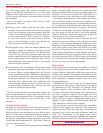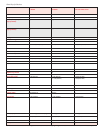
The Color Laser Printer Guide: Industry Briefing
Entire Contents © 2006 Progressive Business Publications. Copying of Pages Prohibited.To Order: 800 247 2185 or www.betterbuys.com 63
cent and that black is much more prevalent than the other
three colors. It is important to keep in mind that estimat-
ing color operating costs is not an exact science. Other
experts in the business differ from Xerox, and we tend to
think that the real-life coverage may average more like 6
or 7 percent per color. Be aware that all vendor cost esti-
mates are probably on the low side.
The method we prefer
In order to compare operating costs, Better Buys for
Business has adopted a standard page definition that —
while it does not set out to be more or less representative
than the others — does provide a simple standard on
which it is easy to make transparent comparisons. The
assumption is simply that there is 5 percent coverage of
each of the four colors in the CMYK palette. We take
into account all consumable items that need regular
replacement, not just the obvious ones such as toner and
the imaging cartridge (drum or belt). This method —
which is also used by most vendors — is really an exten-
sion of the standard we use for comparing black-and-
white costs.
Wha
t to expect
Using this method, the per-page color costs of most
recently introduced color printers fall in the 9–15¢ range,
though a couple of vendors have managed to bring costs
down to 4–5¢. Black-and-white page costs on some color
models typically cluster around 2 or 2.5¢, with a growing
number under 1.5¢.
Kee
p in mind that the mac
hines come with a full set of
starter supplies included in the purchase price (though
sometimes with reduced-capacity toner cartridges). Since
some of
the supply items (such as drums and belts) can
last for tens of thousands of pages, this means that it will
be quite awhile before you actually have to pay the full
cost per page in terms of separately purchased supply
items.
Suppl
y items are discountable, but some brands are
more widely discounted than others.
More About Features
Ne
xt,
a f
e
w w
or
ds on features to look for — but because
none of these are color-specific, we won’t go into a lot of
detail.
PostScript tips
P
ostScript is w
ha
t’
s kno
wn as a “pa
g
e description lan-
gua
g
e”
— it is softw
ar
e that resides within the printer and
governs the way in which the machine handles instruc-
tions from the computer. If you want to read more about
it, there’s a discussion in the Better Buys
Office Laser
Printer Guide (see bac
k co
ver for details).
For now, we’ll just remind you about when you do and
don’t need it. Note that while almost all the printers in
this guide come with PostScript standard, some discus-
sion is still required on the subject.
This is because some
of the least expensive printers we cover — from Konica
Minolta, for example — come without PostScript. So if
you’
re tr
ying to save a buck by buying an inexpensive
printer
, you need to be sure you can live without
PostScript.
So when do you need PostScript? If you use serious
desktop publishing programs (Adobe PageMaker, Quark
XPress, etc.), you definitely need it. The same applies if
you use upscale graphics programs such as Adobe
Illustrator.
If, however, you use only word processing and business
productivity programs, such as Microsoft Word, Excel,
and P
owerPoint, you probably don’t need a PostScript
printer. A PostScript printer will be able to work with
these programs, but it isn’t necessary or even particularly
ad
v
anta
g
eous
.
In this case, you might want to purchase
either a model without PostScript or one that offers it as
an option that you can add later if you need it.
While some printers recently offered Adobe PostScript
Level 2 compatibility, all of the PostScript-capable
mac
hines in this guide suppor
t P
ostScript 3,
w
hic
h offers
a v
ariety of
small enhancements — some of
w
hich are
particularly relevant to color. If you want to match pre-
cise colors on your output, PostScript 3 can be a plus.
The Dell 3110cn includes PostScript, a rare feature among
sub-$500 color laser printer
s.


















